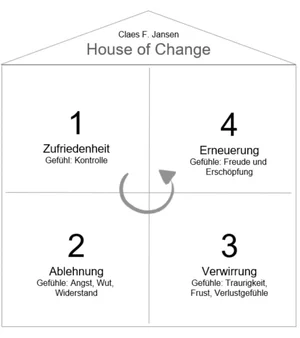Willingness to change among long-term employees
- guidarakp
- Sep 5
- 4 min read

Executive Summary
Change is inevitable in organizations—whether through new processes, restructuring, or digital transformation. Yet employees often respond with resistance, preferring the familiar status quo. Typical reactions such as “It’s always been this way” or “Why does everything have to go digital?” reflect the underlying sense of uncertainty. Resistance is usually rooted in fears—such as being overwhelmed, losing competence, or being excluded from the group. If left unaddressed, this resistance can quickly trigger dynamics that threaten motivation, morale, and project success.
Leaders are required to actively shape this process: through empathy, clear communication, and targeted conversations (e.g., 1:1s). Frameworks such as Lewin’s 3-Phase Model or Janssen’s 4-Room Model provide helpful structures. What matters most is for leaders to act as guides, experts, and mediators at the same time—highlighting opportunities, offering support, and resolving conflicts constructively. Where dialogue and support are not enough, clear boundaries and decisive action are essential. In this way, change becomes an opportunity rather than a barrier.
Introduction
Change is famously the only constant in life. Whether new processes are being introduced, the organization is undergoing restructuring, or an ERP implementation is on the horizon, change is always both an opportunity and a challenge. Nevertheless, it is something that must be addressed—and it becomes all the more important to have the ability to lead through change by example. Over time, every leader will reach a point where they must guide their employees through transition. Experience shows that employees are rarely enthusiastic about change. Over time, such transitions can disrupt harmony as well as hinder progress.
Challenges
As mentioned, change is often not welcomed, since people tend to prefer maintaining the status quo. The following statements may sound familiar:“It’s always been this way”“It has worked fine until now”“Why does everything have to go digital? It worked well before…”
Human beings are creatures of habit and prefer to work within familiar processes and environments. This is why reactions to change are often so negative. In practice, communication with so-called “resisters” can be extremely difficult, sensitive, and repetitive. In conversations, attempts are made to address employees’ concerns, understand their motivations, and gather more information about why they resist change. However, responses often remain superficial, offering little insight beyond the usual tirades.
What makes matters worse is that such employees frequently seek out an audience that is susceptible to influence, drawing others into the pull of “change refusal.” This negatively impacts motivation, overall morale, and performance levels, often triggering a chain reaction in which projects slow down and progress stagnates.
Analyses & Insights
The self-reflective individual recognizes that refusal in most cases is not directed at change itself, but rather at underlying fears or insecurities. As mentioned, these employees often form groups in order to amplify their impact. This leads to hallway conversations, the spreading of unrest, or even the creation of rumors—deliberately aimed at undermining project progress or the credibility of the leader or project manager.
In this context, there is a well-known framework for such behavior:

And it is precisely this framework that can cause devastating damage to both the culture and atmosphere as well as the implementation of projects.
Solution approaches
Resistance to change does not usually stem from the change itself, but from hidden fears or concerns of those affected. The highest priority in such situations is to uncover what the real issue is. For this purpose, a targeted conversation such as a one-on-one should be used. During this, it is important to show empathy and to gain more detail through open-ended questions. Closed questions are not recommended, as they are not known to spark a flow of dialogue.
Show the employees concerned that you are present, that you will guide them through the process, and that you are always available for questions. There are various models from process and change management that can be applied here—for example, Kurt Lewin’s 3-Phase Model:

or Claes Janssen’s 4-Room Model:

In the author’s view, however, it is essential to be aware of the role that must be assumed as a leader. He aims to describe this role in more detail below:
The author emphasizes that it is important for leaders to engage with their employees and address their concerns. However, a leader should not tolerate every type of behavior. If the above aspects of constructive conversations and support models fail to produce results, it may be necessary to take a firmer approach.
For example, if an employee continues to make disparaging comments in project meetings or engages in other forms of sabotage despite multiple attempts at reconciliation, a leader is justified in issuing a formal warning.
It is important that such a warning is legitimate and documented in writing to ensure consistency. It is advisable to consult with the HR department beforehand and communicate your intentions, so that the correct channels are involved. Acting on impulse should be avoided. While it may be tempting to confront the employee publicly in a meeting, this will likely have more negative consequences for the leader than for the employee. The warning should be delivered in a private setting.
The purpose of this approach is to convey that not every situation can be resolved solely through understanding and accommodation. However, it should be noted that such cases are exceptions rather than the rule.
Conclusion
Change is omnipresent and is becoming an increasingly significant and frequent topic within organizations. Employees may refuse to participate for various reasons, and it is the leader’s responsibility to uncover the underlying causes. Clarifying conversations conducted with empathy and trust can be very effective. However, a certain level of personal initiative on the part of the employees is also required.
Comments